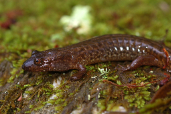Black Mountain Salamander (Desmognathus welteri)
Description: The black mountain salamander is one of a number of similar looking species of dusky salamanders inhabiting the upland locations in which it is found. It has a robust body about 5 inches long with short, stout limbs. The colour is variable but the upper parts are usually pale or medium brown with an indistinct pattern of paler markings. The under side is whitish with dark spots and blotches.
Habitat: Its natural habitats are temperate forests, rivers, freshwater marshes and springs. Habitat includes wooded mountainous countryside where it hides under rocks and logs in swift flowing streams, pools, and wet ditches.
Range: The black mountain salamander is found in an area of the Appalachian Mountains covering about 4,900,000 acres. Its range includes eastern Kentucky, southwestern Virginia, and eastern Tennessee. It is found at heights varying from 980 to 4,000 feet above sea level.
Found in these States:
KY |
TN |
VA |
WV
Diet: The black mountain salamander is very secretive during daytime and may largely forage at night. The diet largely consists of flies, beetles and other insects, and the larvae of flies, butterflies and moths.
Reproduction: Courtship behaviour is not known for the black mountain salamander but reproduction takes place in the spring or summer. The female lays clusters of eggs in or just beside small fast flowing streams, in moist crevices, and among wet leaves in the splash zone. About 25 eggs with short stalks are attached to one another like a bunch of grapes. The eggs have large yolks and the larvae develop for some time inside them. The female guards and broods the eggs until they hatch. The larvae are aquatic and usually occupy quiet shallow areas of streams. The larval period lasts twenty to twenty-four months. After metamorphosis, the juveniles seem to occupy rather deeper water than the adults or spend more time on land, perhaps to avoid competition or to avoid encounters with blackbelly salamanders, which are cannibalistic. Black mountain salamanders are believed to mature at four to five years, at a snout to vent length of about 2.0 inches, and have been known to live for twenty years in captivity.
Status: The population of black mountain salamanders seems to be stable or in slight decline although detailed studies have not been performed. The areas in which it occurs are not heavily populated and its habitat is not under threat. Road building and strip mining have caused an increase in silting in some areas and in West Virginia the salamander is probably now rare.
»» Kingdom: Animalia - Animals
»» Phylum: Chordata - Chordates
»» Subphylum: Vertebrata - Vertebrates
»» Class: Amphibia - (Amphibians)
»» Order: Caudata - Salamanders
»» Family: Plethodontidae - Lungless Salamanders
»» Subfamily: Plethodontinae - Plethodontinae Salamanders
»» Genus: Desmognathus
»» Species: Desmognathus welteri - Black Mountain Salamander
This article uses material from the Wikipedia article "Black Mountain Salamander", which is released under the Creative Commons Attribution-Share-Alike License 3.0. Content may have been omitted from the original, but no content has been changed or extended.
|













